1、基本 Annotation
1.1、限定重写父类方法:@Override
1.2、标记已过时:@Deprecated
1.3、抑制编译器警告:@SuppressWarnings
1.4、Java7 的“堆污染”警告和 @SafeVarargs
1.5、Java8 新增的用于标识(限定)函数式接口:@FunctionalInterface
2、JDK 的元 Annotation
2.1、注解的保留策略限定:@Retention
2.2、注解的作用目标限定:@Target
2.3、@Documented
2.4、@Inherited
2.5、Java8 新增的重复注解:@Repeatable
3、自定义注解
3.1、定义 Annotation
3.2、提取 Annotation 信息
4、使用 “运行时注解“ 的例子
5、“编译时注解”
5.1、"编译时注解" 的简单使用:编译时打印字段字符串
5.2、将注解和注解处理器打成工具 jar 包使用
5.3、使用 ”编译时注解“ 的例子:模拟 lombok 注解 @Data
5.4、eclipse 创建 maven 项目,使用自己写的 Annotation Processor
从 JDK5 开始,Java 增加了对元数据(MetaData)的支持,也就是 Annotation。Annotation 其实就是代码里面的特殊标记,这些标记可以在编译、类加载、运行时被读取,并执行相应的处理。通过使用注解,开发人员可以在不改变原有逻辑的情况下,在源文件中嵌入一些补充信息。代码分析工具、开发工具和部署工具可以通过这些补充信息进行验证或者进行部署。
1、基本 Annotation <--返回目录
Java 提供的 5 个基本 Annotation 如下:
1)Override,2)Deprecated, 3)SuppressWarnings, 4)SafeVarargs, 5)FunctionalInterface
1.1、限定重写父类方法:@Override <--返回目录
@Override 的用法举例:
public class Animal { public void eat() { System.out.println("Animal 的 eat() 方法"); } } class Cat extends Animal { // 使用 @Override 注解指定下面的 eat() 方法必须是重写父类方法 @Override public void eat() { // super.eat(); System.out.println("Cat 的 eat() 方法"); } }
@Override 的源码:
package java.lang; import java.lang.annotation.*; @Target(ElementType.METHOD) @Retention(RetentionPolicy.SOURCE) public @interface Override {}
@Target(ElementType.METHOD):表示 @Override 注解只能标注在方法上。
@Retention(RetentionPolicy.SOURCE):表示 @Override 注解只会保留在源代码中,编译器直接丢弃(class 文件中不保留)。
1.2、标记已过时:@Deprecated <--返回目录
@Deprecated 用于表示某个程序元素(类、方法等)已过时,当程序使用已过时的类、方法时,编译器将会给出警告。
@Deprecated 使用举例:使用已过时的方法 eat(),IDE 会在该方法上加上中划线 “—” 的标识
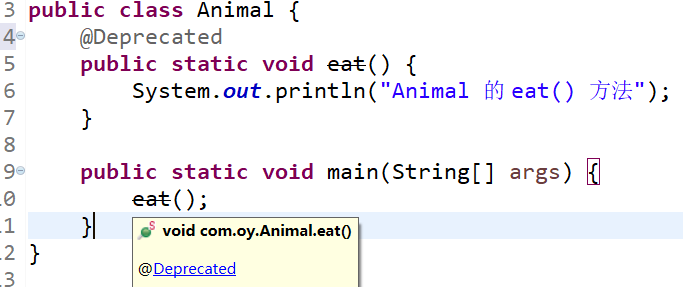
1.3、抑制编译器警告:@SuppressWarnings <--返回目录
@SuppressWarnings 使用举例:
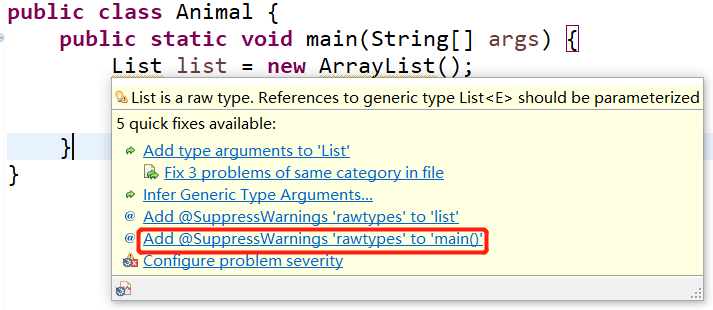
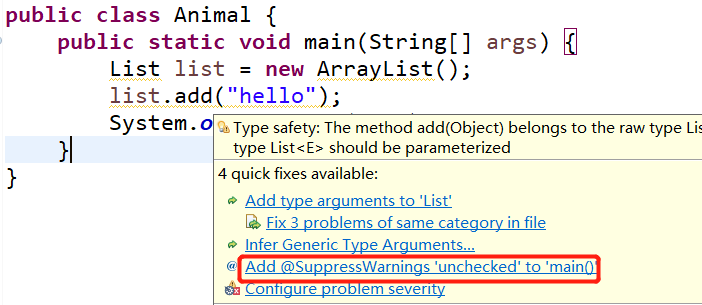

1.4、Java7 的“堆污染”警告和 @SafeVarargs <--返回目录
下面的代码引发错误的原因成为“堆污染”,当把一个不带泛型的对象赋给一个带泛型的对象时,往往就会发生这种“堆污染”。
public static void main(String[] args) { List list = new ArrayList<Integer>(); list.add(10); // 将 list 赋给 list2,编译运行都完全正常 List<String> list2 = list; // 但只要访问list2里面的元素,就会引起运行时异常 /* Exception in thread "main" java.lang.ClassCastException: java.lang.Integer cannot be cast to java.lang.String at com.oy.Animal.main(Animal.java:11) */ System.out.println(list2.get(0)); }
对于形参个数可变的方法,该形参又是泛型,将更容易导致“堆污染”。如下面的代码,listArray 是可变参数,相当于数组,但是Java不支持泛型数组,所以只能把 List<String>... 当成 List[]来处理,这样就发生了“堆污染”,当在访问 listArray 的元素时引起运行时异常。
public class Demo { public static void main(String[] args) { method(Arrays.asList("aaa"), Arrays.asList("bbb")); } public static void method(List<String>... listArray) { List[] array = listArray; array[0] = Arrays.asList(1); // java.lang.Integer cannot be cast to java.lang.String System.out.println(listArray[0].get(0)); } }
但有时候我们知道代码没有问题,我们不想看到这个警告,可以使用 @SafeVarargs 来压制这个警告
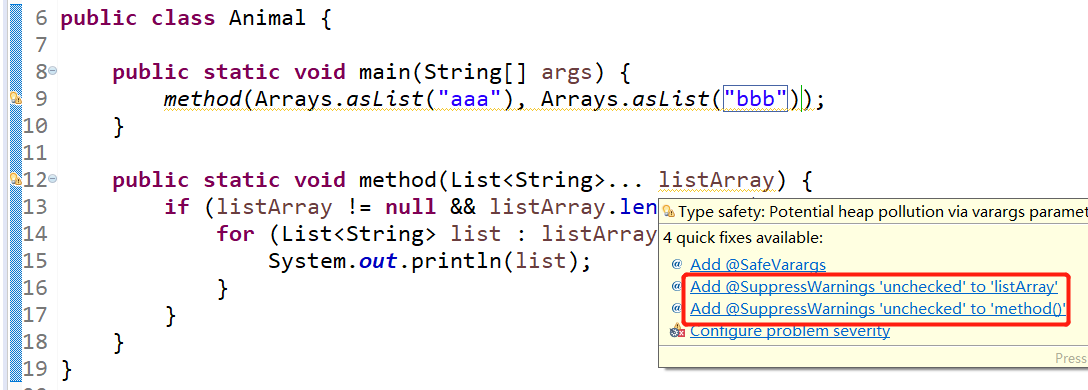
1.5、Java8 新增的用于标识(限定)函数式接口:@FunctionalInterface <--返回目录
如果接口中只有一个抽象方法(可以包含多个默认方法或多个 static 方法),该接口就是函数式接口。@FunctionalInterface 就是用来指定某个接口必须是函数式接口。
@FunctionalInterface 注解只是告诉编译器检查这个接口,保证这个接口只能由一个抽象方法,否则就会报编译出错。

2、JDK 的元 Annotation <--返回目录
JDK 提供了 5 个Meta Annotation(元注解),用于修饰其他的 Annotation 定义,即:
1) Retention, 2) Target, 3) Documented, 4) Inherited, 5) Repeatable。
2.1、注解的保留策略限定:@Retention <--返回目录
@Retention 源码:
@Documented @Retention(RetentionPolicy.RUNTIME) @Target(ElementType.ANNOTATION_TYPE) public @interface Retention { RetentionPolicy value(); }
@Retention 只能用于修饰 Annotation 定义,用于指定被修饰的 Annotation 可以保留多长时间,@Retention 包含一个 RetentionPolicy 类型的 value 成员变量,所以使用 @Retention 时必须为该 value 成员变量指定值。value 成员变量的值只能是如下三个:
RetentionPolicy.SOURCE: Annotation 只保留在源代码中,编译器直接丢弃这种注解。
RetentionPolicy.CLASS: 编译器将把 Annotation 记录在 class 文件中。当运行 Java 程序时,JVM 不可获取该 Annotation 信息。这是默认值。
RetentionPolicy.RUNTIME: 编译器将把 Annotation 记录在 class 文件中。当运行 Java 程序时,JVM 也可获取该 Annotation 信息,程序可以通过反射获取该 Annotation 信息。
定义一个 “编译时注解”:
// RetentionPolicy.SOURCE: 表示此注解只保留在源代码中,编译器直接丢弃这种注解 // 通常称这种注解为 “编译时注解” @Retention(RetentionPolicy.SOURCE) public @interface MyTag { }
定义一个 “运行时注解”:
// RetentionPolicy.SOURCE: 编译器将把 Annotation 记录在 class 文件中。当运行 Java 程序时,JVM 也可获取该 Annotation 信息, // 程序可以通过反射获取该 Annotation 信息。 // 通常称这种注解为 “运行时注解” @Retention(RetentionPolicy.RUNTIME) public @interface MyTag { }
2.2、注解的作用目标限定:@Target <--返回目录
@Target 源码:
@Documented @Retention(RetentionPolicy.RUNTIME) @Target(ElementType.ANNOTATION_TYPE) public @interface Target { ElementType[] value(); }
@Target 包含一个 ElementType[] 类型的 value 成员变量,该成员变量的值只能为如下:
public enum ElementType { /** Class, interface (including annotation type), or enum declaration */ TYPE, /** Field declaration (includes enum constants) */ FIELD, /** Method declaration */ METHOD, /** Formal parameter declaration */ PARAMETER, /** Constructor declaration */ CONSTRUCTOR, /** Local variable declaration */ LOCAL_VARIABLE, /** Annotation type declaration */ ANNOTATION_TYPE, /** Package declaration */ PACKAGE, /** * Type parameter declaration * * @since 1.8 */ TYPE_PARAMETER, /** * Use of a type * * @since 1.8 */ TYPE_USE }
ANNOTATION_TYPE:限定该注解只能用于修饰 Annotation。比如 @Target 定义时就使用的是这个限定。
2.3、@Documented <--返回目录
@Documented 是一个标记注解,没有成员。用于指定此注解是否被javadoc 工具提取成文档。如果定义注解时加上了 @Documented,则使用该注解修饰的程序元素的 API 文档中将会包含该注解说明。
@Documented public @interface MyTag { }
2.4、@Inherited <--返回目录
@Inherited 用于指定被它修改的 Annotation 将具有继承性---如果某个类使用了@Xxx 注解(定义该注解时使用了 @Inherited 修饰),则其子类将自动被 @Xxx 修饰。
@Inherited @Retention(RetentionPolicy.RUNTIME) public @interface MyTag { }
@MyTag class Base { } // 这个类继承了 Base类 // 并未直接使用 @MyTag 修饰, public class TestBase extends Base { public static void main(String[] args) { // isAnnotationPresent: 判断此程序元素是否被某个注解修饰 // 注意:@MyTag 定义时指定保留策略为 RUNTIME System.out.println(TestBase.class.isAnnotationPresent(MyTag.class)); // true } }
2.5、Java8 新增的重复注解:@Repeatable <--返回目录
某些情况下,一个程序元素需要使用多个同一种类型的注解。@Repeatable元注解,顾名思义,重复注解,就是在声明创建注解的时候,指定该注解可以被同一个程序元素多次使用。
使用 @Repeated 举例:
定义一个注解:
package com.oy; import java.lang.annotation.ElementType; import java.lang.annotation.Repeatable; import java.lang.annotation.Retention; import java.lang.annotation.RetentionPolicy; import java.lang.annotation.Target; @Repeatable(Roles.class) @Retention(RetentionPolicy.RUNTIME) @Target(ElementType.TYPE) public @interface Role { // 为该注解定义了一个成员变量 String value(); }
定义一个 “容器” 注解
package com.oy; import java.lang.annotation.ElementType; import java.lang.annotation.Retention; import java.lang.annotation.RetentionPolicy; import java.lang.annotation.Target; @Retention(RetentionPolicy.RUNTIME) @Target(ElementType.TYPE) public @interface Roles { Role[] value(); }
测试
package com.oy; import java.lang.annotation.Annotation;
// 重复使用 @Role 注解 @Role("admin") @Role("user") public class Demo { public static void main(String[] args) { Annotation[] annotations = Demo.class.getAnnotations(); for (Annotation a : annotations) { // @com.oy.Roles(value=[@com.oy.Role(value=admin), @com.oy.Role(value=user)]) System.out.println(a); } // getDeclaredAnnotationsByType: 可以获取多个重复注解 Role[] array = Demo.class.getDeclaredAnnotationsByType(Role.class); for (Role r: array) { // @com.oy.Role(value=admin) // @com.oy.Role(value=user) System.out.println(r); System.out.println(r.value()); } } }
3、自定义注解 <--返回目录
3.1、定义 Annotation <--返回目录
定义注解时,定义了一个成员变量 name, 并且指定了默认值
import java.lang.annotation.Documented; import java.lang.annotation.ElementType; import java.lang.annotation.Retention; import java.lang.annotation.RetentionPolicy; import java.lang.annotation.Target; @Documented @Retention(RetentionPolicy.RUNTIME) @Target({ ElementType.TYPE, ElementType.METHOD }) public @interface MyTag { String name() default "hello"; }
根据 Annotation 是否包含成员变量,将 Annotation 分为如下两类:
1)标记 Annotation:没有定义成员变量。这种 Annotation 仅利用自身的存在与否来提供信息,如前面介绍的 @Override等。
2)元数据 Annotation:包含成员变量。
3.2、提取 Annotation 信息 <--返回目录
使用 Annotation 修饰了类、方法、成员变量等成员之后,这些 Annotation 不会自己生效,必须由开发者提供相应的工具来提取并处理 Annotation 信息。
Java 使用 Annotation 接口来代表程序元素前面的注解,该接口是所有注解的父接口。Java5 在java.lang.reflect 包下新增了 AnnotatedElement 接口,该接口代码程序中可以接受注解的程序元素。该接口主要有如下几个实现类:
1)Class: 类定义;
2)Constructor: 构造器定义;
3)Field:类的成员变量定义;
4)Method:类的方法定义;
5)Package:类的包定义;
java.lang.reflect 包下主要包含一些实现反射功能的工具类,从 Java5 开始,java.lang.reflect 包所提供的反射 API 增加了读取运行时 Annotation 的能力。只有当定义 Annotation 时使用了 @Retention(RerentionPolicy.RUNTIME) 修饰,该 Annotation 才会在运行时可见,JVM 才会在加载 class 字节码文件时读取保存在 class 文件中的 Annotation 信息。
反射获取注解信息的 API:
1)<A extends Annotation> A getAnnotation(Class<a> annotationClass): 返回该程序元素上存在的指定类型的注解,如果指定的注解不存在,返回null;
2)<A extends Annotation> A getDeclaredAnnotation(Class<a> annotationClass): 这是 Java8 新增的方法,该方法尝试获取直接修饰该程序元素的指定类型的注解,如果指定的注解不存在,返回null;
3)Annotation[] getAnnotations(): 返回该程序元素上存在的所有注解;
4)Annotation[] getDeclaredAnnotations(): 返回直接修饰该程序元素的所有注解;
5)boolean isAnnotationPresent(Class<? extends Annotation) annotationClass): 判断该程序元素上是否存在指定类型的注解,存在返回 true,否则返回 false;
6)<A extends Annotation> A[] getAnnotationsByType(class<A> annotationClass): 与 getAnnotation() 功能类似,但是可以获取指定类型的重复注解 ;
7)<A extends Annotation> A[] getDeclaredAnnotationsByType(class<A> annotationClass): 与 getDeclaredAnnotation() 类似,但是可以获取直接修复该程序元素的指定类型的重复注解 ;
4、使用 “运行时注解“ 的例子 <--返回目录

自定义注解 @Test
package com.oy; import java.lang.annotation.ElementType; import java.lang.annotation.Retention; import java.lang.annotation.RetentionPolicy; import java.lang.annotation.Target; @Retention(RetentionPolicy.RUNTIME) @Target(ElementType.METHOD) public @interface Test { boolean value(); }
测试使用该注解:
package com.oy; import java.lang.reflect.Method; public class Demo { public static void main(String[] args) { for (Method method : Demo.class.getMethods()) { // 方法上没有标注 @Test 注解,不处理 if (!method.isAnnotationPresent(Test.class)) continue; // @Test(false) 不处理 Test test = method.getAnnotation(Test.class); if (!test.value()) continue; // 执行 @Test(true) 标注的方法 try { method.invoke(null); } catch (Exception e) { e.printStackTrace(); } } } @Test(true) public static void test1() { System.out.println("test1..."); } @Test(false) public static void test2() { System.out.println("test2..."); } public static void test3() { System.out.println("test3..."); } }
更多使用 “运行时注解“ 的例子可以参考博客:
1)springboot + 注解 + 拦截器 + JWT 实现角色权限控制
2)Java + SpringBoot + 自定义注解 + 拦截器实现 BASIC 认证
5、“编译时注解” <--返回目录
RetentionPolicy.SOURCE: Annotation 只保留在源代码中,编译器直接丢弃这种注解。这种注解通常称为 “编译时注解”,编译器在对源码进行编译时读取注解信息,做一些额外的处理。
APT:Annotation Processing Tool, 是一种注解处理工具,它对源代码进行检查,并找出源文件所包含的注解信息,然后针对注解信息进行额外的处理。使用 APT 的主要目的是简化开发者的工作量,因为 APT 可以在编译程序源代码的同时生成一些附加文件(比如源文件、类文件、程序发布描述文件等),这些附属文件的内容也都与源代码有关。换句话说,使用 APT 可以替代传统的对代码信息和附属文件的维护工作。
Java 提供的 javac.exe 工具有一个 -processor 选项,该选项可以指定一个 Annotation 处理器,如果在编译源文件时通过该选项指定了 Annotation 处理器,那么这个 Annotation 处理器将会在编译时提取并处理 Java 源文件种的 Annotation信息。
每个 Annotation 处理器都需要实现 javax.annotation.processing 包下的 Processor 接口。不过实现该接口要实现它里面所有的方法,因此通常会采用继承 AbstractProcessor 的方式来编写 Annotation 处理器。一个 Annotation 处理器可以处理一个或多个 Annotation 类型。一个继承 AbstractProcessor 的举例如下:
import java.util.LinkedHashSet; import java.util.Set; import javax.annotation.processing.AbstractProcessor; import javax.annotation.processing.ProcessingEnvironment; import javax.annotation.processing.RoundEnvironment; import javax.annotation.processing.SupportedAnnotationTypes; import javax.annotation.processing.SupportedSourceVersion; import javax.lang.model.SourceVersion; import javax.lang.model.element.TypeElement; public class MyProcessor extends AbstractProcessor { @Override public boolean process(Set<? extends TypeElement> annoations, RoundEnvironment env) { return false; } @Override public Set<String> getSupportedAnnotationTypes() { Set<String> annotataions = new LinkedHashSet<String>(); annotataions.add("com.example.MyAnnotation"); return annotataions; } @Override public SourceVersion getSupportedSourceVersion() { return SourceVersion.latestSupported(); } @Override public synchronized void init(ProcessingEnvironment processingEnv) { super.init(processingEnv); } }
其中,init(ProcessingEnvironment processingEnv):所有的注解处理器类都必须有一个无参构造函数。然而,有一个特殊的方法init(),它会被注解处理工具调用,以ProcessingEnvironment作为参数。ProcessingEnvironment 提供了一些实用的工具类Elements, Types和Filer。
process(Set annoations, RoundEnvironment env):这类似于每个处理器的main()方法。你可以在这个方法里面编码实现扫描,处理注解,生成 java 文件。使用RoundEnvironment 参数,你可以查询被特定注解标注的元素。
getSupportedAnnotationTypes():在这个方法里面你必须指定哪些注解应该被注解处理器注册。注意,它的返回值是一个String集合,包含了你的注解处理器想要处理的注解类型的全称。换句话说,你在这里定义你的注解处理器要处理哪些注解。
getSupportedSourceVersion():用来指定你使用的 java 版本。通常你应该返回SourceVersion.latestSupported()。不过,如果你有足够的理由坚持用 java 6 的话,你也可以返回SourceVersion.RELEASE_6。
关于getSupportedAnnotationTypes()和getSupportedSourceVersion()这两个方法,你也可以使用相应注解进行代替。代码如下:
@SupportedSourceVersion(SourceVersion.RELEASE_8) @SupportedAnnotationTypes("com.example.MyAnnotation") public class MyProcessor extends AbstractProcessor { ....
5.1、"编译时注解" 的简单使用:编译时打印字段字符串 <--返回目录
分别编译 DataTest 和 MyProcessor, 然后使用 "javac -process 注解处理器 类名.java" 命令编译使用 @DataTest 注解的类
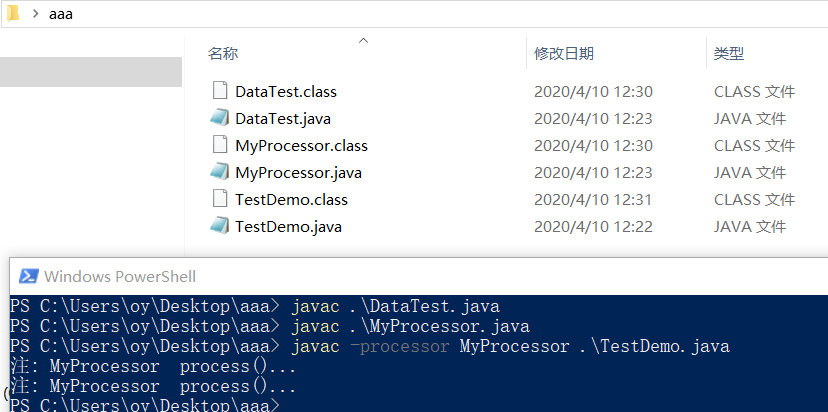
DataTest 注解的定义
import java.lang.annotation.Retention; import java.lang.annotation.RetentionPolicy; @Retention(RetentionPolicy.SOURCE) public @interface DataTest { }
注解处理器 MyProcessor
import java.util.Set; import javax.annotation.processing.AbstractProcessor; import javax.annotation.processing.ProcessingEnvironment; import javax.annotation.processing.Processor; import javax.annotation.processing.RoundEnvironment; import javax.annotation.processing.SupportedAnnotationTypes; import javax.annotation.processing.SupportedSourceVersion; import javax.lang.model.SourceVersion; import javax.lang.model.element.TypeElement; import javax.tools.Diagnostic; @SupportedAnnotationTypes("DataTest") @SupportedSourceVersion(SourceVersion.RELEASE_8) public class MyProcessor extends AbstractProcessor { private ProcessingEnvironment processingEnv; @Override public synchronized void init(ProcessingEnvironment processingEnv) { this.processingEnv = processingEnv; } @Override public boolean process(Set<? extends TypeElement> annotations, RoundEnvironment roundEnv) { processingEnv.getMessager().printMessage(Diagnostic.Kind.NOTE, "MyProcessor process()..."); return false; } }
测试类 TestDemo
@DataTest public class TestDemo { public static void main(String[] args) { System.out.println("main run..."); } }
5.2、将注解和注解处理器打成工具 jar 包使用 <--返回目录
上面的例子简单演示了 “javac -processor 注解处理器 类名.java” 命令的使用。开发中可能需要将注解和注解处理器打成工具 jar 包使用。
步骤1:新建一个 maven 工程:
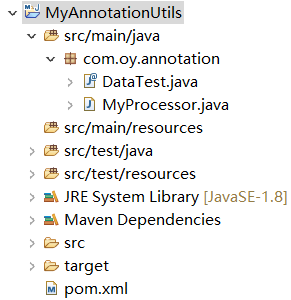
pom.xml 文件

<project xmlns="http://maven.apache.org/POM/4.0.0" xmlns:xsi="http://www.w3.org/2001/XMLSchema-instance" xsi:schemaLocation="http://maven.apache.org/POM/4.0.0 http://maven.apache.org/xsd/maven-4.0.0.xsd"> <modelVersion>4.0.0</modelVersion> <groupId>com.oy</groupId> <artifactId>MyAnnotationUtils</artifactId> <version>0.0.1-SNAPSHOT</version> <dependencies> <!-- https://mvnrepository.com/artifact/com.squareup/javawriter --> <dependency> <groupId>com.squareup</groupId> <artifactId>javawriter</artifactId> <version>2.5.1</version> </dependency> <!-- https://mvnrepository.com/artifact/com.google.auto.service/auto-service --> <dependency> <groupId>com.google.auto.service</groupId> <artifactId>auto-service</artifactId> <version>1.0-rc5</version> </dependency> </dependencies> <build> <plugins> <plugin> <groupId>org.apache.maven.plugins</groupId> <artifactId>maven-compiler-plugin</artifactId> <configuration> <source>1.8</source> <target>1.8</target> </configuration> </plugin> </plugins> </build> </project>
DataTest

package com.oy.annotation; import java.lang.annotation.Retention; import java.lang.annotation.RetentionPolicy; @Retention(RetentionPolicy.SOURCE) public @interface DataTest { }
MyProcessor

package com.oy.annotation; import java.util.Set; import javax.annotation.processing.AbstractProcessor; import javax.annotation.processing.ProcessingEnvironment; import javax.annotation.processing.Processor; import javax.annotation.processing.RoundEnvironment; import javax.annotation.processing.SupportedAnnotationTypes; import javax.annotation.processing.SupportedSourceVersion; import javax.lang.model.SourceVersion; import javax.lang.model.element.TypeElement; import javax.tools.Diagnostic; import com.google.auto.service.AutoService; @SupportedAnnotationTypes("com.oy.annotation.DataTest") @SupportedSourceVersion(SourceVersion.RELEASE_8) @AutoService(Processor.class) public class MyProcessor extends AbstractProcessor { private ProcessingEnvironment processingEnv; @Override public synchronized void init(ProcessingEnvironment processingEnv) { this.processingEnv = processingEnv; } @Override public boolean process(Set<? extends TypeElement> annotations, RoundEnvironment roundEnv) { processingEnv.getMessager().printMessage(Diagnostic.Kind.NOTE, "MyProcessor process..."); return false; } }
步骤2:选择项目,右键 ==> Run as => Maven build... => clean package, 会在项目根目录的 target 目录下生成 MyAnnotationUtils.jar, 从而可以在其他项目中使用。

步骤三:新建一个目录,将MyAnnotaionUtils.jar 复制到这个目录

解压这个jar会发现,在 META-INF/services 下面会有个文件 javax.annotation.processing.Processor,是 @AutoService 注解帮助生成的。

步骤四:编写测试类 TestDemo

import com.oy.annotation.DataTest; @DataTest public class TestDemo { public static void main(String[] args) { System.out.println("main run..."); } }
步骤五:执行 "java -cp MyAnnotationUtils.jar TestDemo.java" 命令

5.3、使用 ”编译时注解“ 的例子:模拟 lombok 注解 @Data <--返回目录
参考:基于注解处理器开发自动生成getter和setter方法的插件
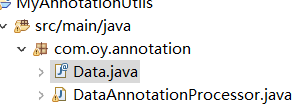
pom.xml与上面的例子一样,都引入了依赖'com.squareup:javawriter:2.5.1' 和 ‘com.google.auto.service:auto-service:1.0-rc5’
Data

package com.oy.annotation; import java.lang.annotation.ElementType; import java.lang.annotation.Retention; import java.lang.annotation.RetentionPolicy; import java.lang.annotation.Target; @Retention(RetentionPolicy.SOURCE) @Target(ElementType.TYPE) public @interface Data { }
DataAnnotationProcessor

package com.oy.annotation; import java.io.IOException; import java.io.Writer; import java.util.EnumSet; import java.util.HashMap; import java.util.List; import java.util.Map; import java.util.Set; import javax.annotation.processing.AbstractProcessor; import javax.annotation.processing.Filer; import javax.annotation.processing.Messager; import javax.annotation.processing.ProcessingEnvironment; import javax.annotation.processing.Processor; import javax.annotation.processing.RoundEnvironment; import javax.annotation.processing.SupportedAnnotationTypes; import javax.annotation.processing.SupportedSourceVersion; import javax.lang.model.SourceVersion; import javax.lang.model.element.Element; import javax.lang.model.element.ElementKind; import javax.lang.model.element.Modifier; import javax.lang.model.element.Name; import javax.lang.model.element.TypeElement; import javax.lang.model.type.TypeMirror; import javax.lang.model.util.Elements; import javax.tools.Diagnostic; import javax.tools.JavaCompiler; import javax.tools.JavaFileObject; import javax.tools.StandardJavaFileManager; import javax.tools.ToolProvider; import com.google.auto.service.AutoService; import com.squareup.javawriter.JavaWriter; @SupportedSourceVersion(SourceVersion.RELEASE_8) @SupportedAnnotationTypes({"com.oy.annotation.Data"}) @AutoService(Processor.class) public class DataAnnotationProcessor extends AbstractProcessor { private Messager messager; // 用于打印日志 private Elements elementUtils; // 用于处理元素 private Filer filer; // 用来创建java文件或者class文件 @Override public synchronized void init(ProcessingEnvironment processingEnv) { super.init(processingEnv); messager = processingEnv.getMessager(); elementUtils = processingEnv.getElementUtils(); filer = processingEnv.getFiler(); } // @Override // public SourceVersion getSupportedSourceVersion() { // return SourceVersion.latestSupported(); // } // // @Override // public Set<String> getSupportedAnnotationTypes() { // Set<String> set = new HashSet<>(); // set.add(Data.class.getCanonicalName()); // return Collections.unmodifiableSet(set); // } @Override public boolean process(Set<? extends TypeElement> annotations, RoundEnvironment roundEnv) { messager.printMessage(Diagnostic.Kind.NOTE, "-----开始自动生成源代码"); try { // 标识符 boolean isClass = false; // 类的全限定名 String classAllName = null; // 返回被注释的节点 Set<? extends Element> elements = roundEnv.getElementsAnnotatedWith(Data.class); Element element = null; for (Element e : elements) { // 如果注释在类上 if (e.getKind() == ElementKind.CLASS && e instanceof TypeElement) { TypeElement t = (TypeElement) e; isClass = true; classAllName = t.getQualifiedName().toString(); element = t; break; } } // 未在类上使用注释则直接返回,返回false停止编译 if (!isClass) { return true; } // 返回类内的所有节点 List<? extends Element> enclosedElements = element.getEnclosedElements(); // 保存字段的集合 Map<TypeMirror, Name> fieldMap = new HashMap<>(); for (Element ele : enclosedElements) { if (ele.getKind() == ElementKind.FIELD) { // 字段的类型 TypeMirror typeMirror = ele.asType(); // 字段的名称 Name simpleName = ele.getSimpleName(); fieldMap.put(typeMirror, simpleName); } } // 生成一个Java源文件(文件名为 类名.java) JavaFileObject sourceFile = filer.createSourceFile(getClassName(classAllName)); // 写入代码 createSourceFile(classAllName, fieldMap, sourceFile.openWriter()); // 手动编译 compile(sourceFile.toUri().getPath()); } catch (IOException e) { messager.printMessage(Diagnostic.Kind.ERROR, e.getMessage()); } messager.printMessage(Diagnostic.Kind.NOTE, "-----完成自动生成源代码"); return true; } private void createSourceFile(String classAllName, Map<TypeMirror, Name> fieldMap, Writer writer) throws IOException { // 生成源代码 JavaWriter jw = new JavaWriter(writer); jw.emitPackage(getPackage(classAllName)); jw.beginType(getClassName(classAllName), "class", EnumSet.of(Modifier.PUBLIC)); for (Map.Entry<TypeMirror, Name> map : fieldMap.entrySet()) { String type = map.getKey().toString(); String name = map.getValue().toString(); // 字段 jw.emitField(type, name, EnumSet.of(Modifier.PRIVATE)); } for (Map.Entry<TypeMirror, Name> map : fieldMap.entrySet()) { String type = map.getKey().toString(); String name = map.getValue().toString(); // getter jw.beginMethod(type, "get" + humpString(name), EnumSet.of(Modifier.PUBLIC)).emitStatement("return " + name) .endMethod(); // setter jw.beginMethod("void", "set" + humpString(name), EnumSet.of(Modifier.PUBLIC), type, "arg") .emitStatement("this." + name + " = arg").endMethod(); } jw.endType().close(); } /** * 编译文件 * * @param path * @throws IOException */ private void compile(String path) throws IOException { // 拿到编译器 JavaCompiler complier = ToolProvider.getSystemJavaCompiler(); // 文件管理者 StandardJavaFileManager fileMgr = complier.getStandardFileManager(null, null, null); // 获取文件 Iterable units = fileMgr.getJavaFileObjects(path); // 编译任务 JavaCompiler.CompilationTask t = complier.getTask(null, fileMgr, null, null, null, units); // 进行编译 t.call(); fileMgr.close(); } /** * 驼峰命名 * * @param name * @return */ private String humpString(String name) { String result = name; if (name.length() == 1) { result = name.toUpperCase(); } if (name.length() > 1) { result = name.substring(0, 1).toUpperCase() + name.substring(1); } return result; } /** * 从带包类名读取类名 * * @param classAllName 带包类名 * @return */ private String getClassName(String classAllName) { String result = classAllName; if (classAllName.contains(".")) { result = classAllName.substring(classAllName.lastIndexOf(".") + 1); } return result; } /** * 从带包类名读取包名 * * @param classAllName 带包类名 * @return */ private String getPackage(String classAllName) { String result = classAllName; if (classAllName.contains(".")) { result = classAllName.substring(0, classAllName.lastIndexOf(".")); } else { result = ""; } return result; } }
测试使用:
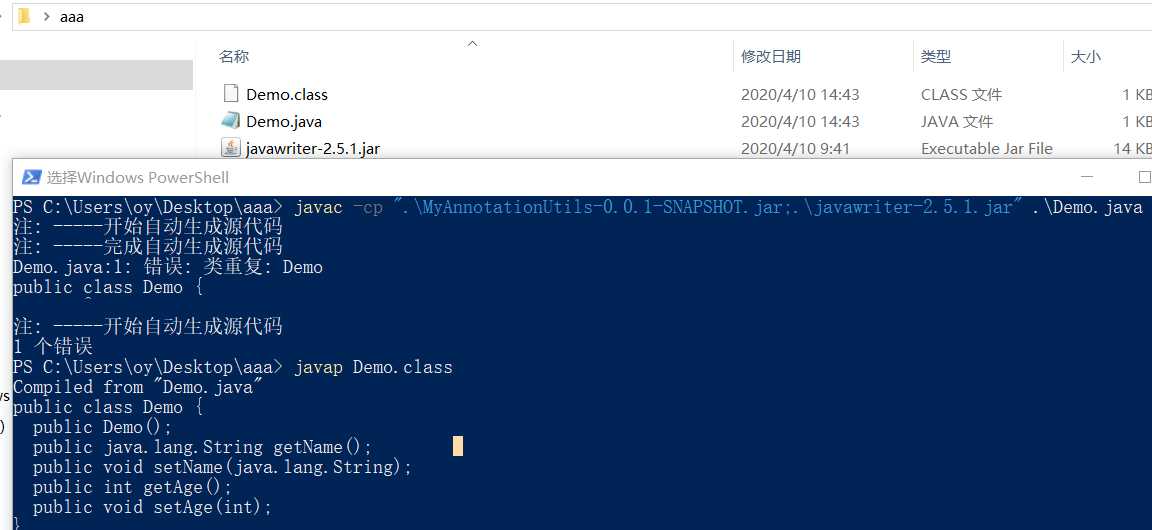
5.4、eclipse 创建 maven 项目,使用自己写的 Annotation Processor <--返回目录
首先将自己写的 Annotation Processor(maven 项目)打包到本地仓库:

新建一个 mavenDemo 项目,在 pom.xml 添加对 自己写的 Annotation Processor 的依赖:
<dependency>
<groupId>com.oy</groupId>
<artifactId>MyAnnotationUtils</artifactId>
<version>0.0.1-SNAPSHOT</version>
</dependency>

然后,选中 MavenDemo 项目,右键-> run as -> maven build... -> clean compile -> 在 target 目录下生成如下文件:

这个例子会报 com.oy.Demo 类重复的错,因为原来的Demo 类没删,所以重复了。
参考:
1)《疯狂 Java 讲义》--李刚
2)基于注解处理器开发自动生成getter和setter方法的插件
3)javawriter 的使用:生成Java源文件 (javawriter, javapoet, codemodel)
